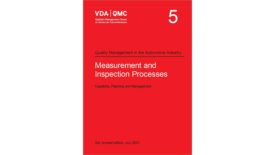Home » Keywords: » process improvement
Items Tagged with 'process improvement'
ARTICLES
Face of Quality | Jim L. Smith
Organizations Need to Assess Risk Level and Take Appropriate Actions
Managing risk.
June 11, 2024
Measurement
The new VDA Volume 5 – Obligation and Opportunity
Too much measurement uncertainty leads to incorrect conformity decisions, incorrect assessment of machines and production processes, poorer process quality and thus, increased production and testing effort.
December 29, 2023
Face of Quality | Jim L. Smith
Part 2: Delivering the Best
We need to establish clarity about what is expected.
September 27, 2023
Case Study: Lean Manufacturing 101
Optikos Corp. Clearly Focused on Process Improvement
Talented quality personnel and engineers from a leading manufacturer of metrology products share their quality process improvements.
July 5, 2023
Sponsored Content
Predictive Analytics Comes of Age in Manufacturing
Minitab Predictive Analytics with Auto ML makes predictive analytics more accessible to the masses.
February 14, 2022
Sponsored Content
The 4 Simple Steps for Creating a Monte Carlo Simulation with Engage or Workspace
Monte Carlo simulations specialize in computing reliable probabilities from simulated data.
February 14, 2022
Sponsored Content
Helping Tate & Lyle Ensure Sweeteners Feel More Like Plain Sugar
When they faced a challenge in the process of refining corn sugars, Tate & Lyle turned to Minitab software for assistance.
February 11, 2022
Stay in the know with Quality’s comprehensive coverage of
the manufacturing and metrology industries.
eNewsletter | Website | eMagazine
JOIN TODAY!Copyright ©2024. All Rights Reserved BNP Media.
Design, CMS, Hosting & Web Development :: ePublishing










